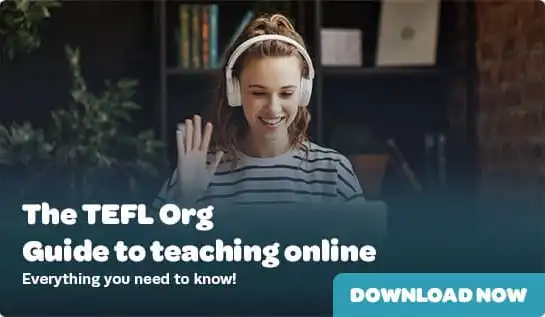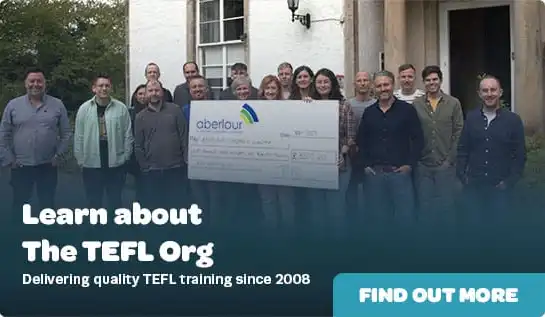- TEFL Courses TEFL Courses
- View all TEFL courses
- 120-hour Premier Online TEFL Course
- 200-hour Level-5 Online TEFL Course
- Online TEFL Courses
- Classroom TEFL Courses
- Combined TEFL Courses
- Virtual TEFL Courses
- TEFL Course Bundles NEW
- Advanced TEFL Courses
- TEFL Lesson Plans & Resources
- TEFL Gift Vouchers
- Which TEFL course is right for you?

- New to TEFL New to TEFL
- Locations
- TEFL Jobs
- Teach Abroad Teach Abroad
- Teach English Abroad
- Teach English in Japan
- Teach English in South Korea
- Teach English in Spain
- Teach English in China
- TEFL Salaries Abroad
- Requirements for teaching abroad
- Teach English abroad without a degree
- How to find teaching jobs abroad without experience
- Can you teach English abroad as a non-native speaker?

- Teach Online
- About Us
- Blog
- Podcast

Teaching English Online with Cambly: Poppy’s Story

Two years ago, after graduating with a degree in English and Journalism, I set off to Australia on a working holiday to escape the Scottish weather and hopefully kill my travel bug.
I soon found myself working day and night in a German pub serving beer and sausages, which if I’m honest, was not ideal. Googling ‘how to make money abroad’ became a daily occurrence. Many jobs kept popping up – pick fruit, become a nanny, clean hostels - but there was only one that caught my imagination: teach English online.
A job where I could make money from my sofa sounded too good to be true. I was intrigued, but unfortunately there was one problem – I didn’t have a TEFL certificate.Getting TEFL qualified
I researched course providers and The TEFL Org consistently came out on top. The reviews were great, it was internationally recognised, and the employment rate was high. I wanted to make sure I became a qualified teacher with an accredited and trustworthy company.But, being a backpacker living in a hostel, I didn’t have the money to spare on a course. I reluctantly put the idea on the backburner.
When I returned home the following year, I was still eager to try my hand at online English teaching, so I finally enrolled in TEFL Org’s 120-hour online course . I was given instant access to the online course materials, quickly assigned a tutor, and began studying the same day my confirmation email arrived.
Distance learning made it easy for me to balance the course alongside my waitressing job and I managed to complete it within 12 weeks. It was challenging at times – particularly the grammar unit! - but the interesting lesson content made it enjoyable and my tutor was always quick to get back to me with help and feedback.
Finding an online job

For a couple of reasons – the main one being my busy schedule - I didn’t immediately start looking for work once I was qualified. But, a few months later, COVID-19 changed everything. The UK went into lockdown and I was furloughed. I suddenly had lots of time and no excuses, so the search for an online teaching job begun.
The demand for online English teachers was high due to school closures around the world, so I applied to a number of companies. The application process was different for each platform, but usually consisted of a 1-2 minute ‘intro video’ and a mock lesson. Filming a mock lesson felt bonkers (the first time anyway) as I was literally teaching a stock image, but I gave it my best shot. When it came to shooting the introduction video I must have recorded around 60 takes before I was happy (I wish that was an exaggeration). But overall the application process was simple and straightforward.
Within a fortnight I had been accepted by Palfish and Preply, two reputable ESL companies. I was then contacted and approved by Cambly six weeks later. Every platform is different, from the clientele to the curriculum to the pay scale, so I was grateful to have the opportunity to try out a few and see what style of teaching I enjoyed most.
Teaching English online with Cambly
I soon found that Cambly was the best teaching platform for me, though I also really liked working for Palfish. Cambly is an American company with students across the world, from Saudi Arabia to Turkey, Brazil, Russia and Japan. An international student-base means there is a demand for classes 24/7, and I love speaking to people from a wide range of cultures.I started teaching on Cambly and Cambly Kids (two programmes under the same umbrella) in April and I couldn’t believe how quickly my schedule started filling up. Within my first week of teaching I had ‘regulars’ who had booked me for the rest of the month! I was thrilled. Tutors on Cambly earn for every minute they spend chatting. I make $0.17/min ($10.20/hour) on Cambly and $0.20/min ($12.00/hour) on Cambly Kids, and I get paid via PayPal weekly.
The style of teaching on Cambly is very relaxed. The majority of students are intermediate or advanced speakers and simply want the opportunity to practice their conversational skills with a native speaker. My students and I usually chat about anything from family to current affairs - as you can imagine, the current pandemic has been a useful icebreaker at times. Sometimes we read articles and discuss them together. I like to bookmark various sites with interesting conversation starters and articles, so I have material ready-to-go when need be.
The different types of students on Cambly

On Cambly Kids there are lesson plans to guide the class, which are extremely easy to follow and require zero prep. There is also no obligation to finish the slides - if a child just wants to chat or play a game of hangman, then that’s what we do. Most parents are happy for their child to simply practice their conversational skills. When I first started teaching children, I purchased a bunch of flashcards and a puppet on Amazon. I have since made my own props using popsicle sticks and laminated pictures, which have proved useful.
As well as general conversational skills, there are many other niches a teacher can choose to specialise in on Cambly, be it Business English, grammar, accent coaching, idioms and slang or manners and customs. I’ve personally chosen to focus on general conversation and IELTS (International English Language Testing System). The IELTS is a test of English language proficiency for non-native English language speakers. Many students need to pass this test with a high score before they can study or work in an English-speaking country.The flexibility of working hours on Cambly is also a great advantage. I can choose to open my schedule as little or as much as I want, at any time of day or night. I change my hours depending on how my week is looking or what I need to save for. I recently treated myself to a treadmill and decided to pay it off by working one extra hour every day until October – being in control of my time and income like this is very satisfying.
The benefits of teaching English online
I think the most exciting thing about teaching online is the portability. It’s safe to say I am still itching to travel, and I love knowing if I wanted to move to Vietnam tomorrow and make a living out there, I could - so long as I don’t forget to pack my laptop. Maybe I will, maybe I won’t, but the option is nice.It also blows me away that I often don’t know who I will meet or where I will go on any particular day. Since April, I’ve walked along the beach in Saudi Arabia, I’ve been inside a hospital staff room in Dubai, I’ve sat on a sunny rooftop in Brazil, and I’ve even taught from the dashboard during several Istanbul rush hours.
When I first started teaching online, I never would have expected to form the friendships I now have with my regular students. It’s a real privilege to become a small part of someone’s life on the other side of the world and see their English improve and confidence grow week-by-week.
I feel so fortunate to have discovered online English teaching as a career option and I can’t wait to see where this ever-changing industry goes in the coming years.
You can follow Poppy on Instagram and Twitter .









